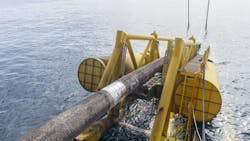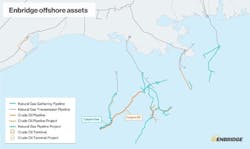Recent project FIDs usher in Gulf of Mexico pipeline revival
By Bruce Beaubouef, Managing Editor
The recent sanctioning of major deepwater projects in the US Gulf of Mexico this year has in turn led to a spate of new pipeline projects to bring that crude oil and natural gas production to market.
In particular, bp’s FID of its Kaskida field development project and Shell’s FID of its Sparta field development project has spurred an array of engineering and construction jobs, including efforts to design and build new semisubmersible platforms and an array of subsea production systems.
These projects have also led to a revival of new plans for large-diameter pipeline systems in the Gulf of Mexico at a level that has not been seen for years. Both Enbridge and Shell have announced plans for new export and gathering systems that will move crude oil and natural gas produced from Kaskida and Sparta to existing systems or onshore markets.
For Kaskida, Enbridge has announced plans to build the Canyon oil and gas pipeline systems, which will be designed to move 200,000 barrels per day of crude oil and 125 million cubic feet per day of natural gas from the deepwater Gulf to existing systems.
The Canyon oil pipeline system will originate in the Keathley Canyon area and deliver crude to the existing Green Canyon 19 platform, operated by Shell Pipeline Company LP for ultimate delivery to the Louisiana market.
The Canyon gas gathering system will run from the Keathley Canyon area and will connect to Enbridge’s existing Magnolia gas gathering pipeline, which then delivers to Enbridge’s Garden Banks gas pipeline.
Enbridge says that its agreements with BP Exploration & Production Company contain options which bp may elect to exercise in order to connect potential future production from its emerging Paleogene portfolio into the newly developed pipelines. Both the Canyon oil and the Canyon gas pipelines are being designed to accommodate connections from nearby discoveries.
Enbridge says that the Canyon oil pipeline system will run approximately 140 miles in length with 24 and 26-in. diameter pipe. The Canyon gas gathering system will be approximately 60 miles in length and will run with 12-in. diameter pipe. Both pipelines will originate in Keathley Canyon block 293 in approximately 5,900 feet of water. If options are exercised by bp, the Canyon oil pipeline would increase its length to approximately 200 miles and the Canyon gas gathering system would increase its length to approximately 115 miles. Detailed design and procurement activities will commence in early 2025 with the pipelines expected to be operational by 2029. The cost of the pipelines will be approximately $700 million.
At the same time that Enbridge made its announcement, Shell announced that it had issued an FID for its Rome pipeline system, which will move crude oil produced from Kaskida to onshore markets. The new pipeline, which will be roughly 100 miles in length, will transport crude oil from Shell’s Green Canyon block 19 pipeline hub platform to its Fourchon Junction facility on the Louisiana Gulf Coast. In conjunction with this announcement, Shell and BP America Production Company entered into an agreement for the Rome pipeline to export 100% of the oil production from Kaskida.
The Rome pipeline will begin at Shell’s Green Canyon block 19 hub, where it will tie into the Enbridge Canyon oil pipeline. Shell says that the Rome pipeline will then run adjacent to existing corridor pipelines to reach the Fourchon Junction facility. Pending applicable permitting and regulatory agency approvals, the Rome pipeline is projected to begin operation in 2028.
Shell says that the pipeline will bring additional capacity to its extensive Gulf of Mexico pipeline footprint, expanding support for domestic oil production in the western and central areas of the Gulf. The company owns and operates the Green Canyon block 19 hub, a fixed platform which resides in 750 feet of water. It currently provides existing pipeline access to the Amberjack, Boxer, Eugene Island and CHOPS pipeline systems in the Gulf of Mexico. “This investment will reinforce Shell’s strategic position in the US Gulf of Mexico through enhanced oil transport capacity, flexibility and efficiency,” said Andrew Smith, Shell’s Executive Vice President of Trading and Supply.
For Sparta, Enbridge announced in March that it had sanctioned $200 million in new deepwater oil and gas pipelines to service the new field development project. Owned by Shell and Equinor, Sparta will feature a semisubmersible production host in a depth of more than 4,700 feet of water, initially with eight oil and gas producing wells in the Garden Banks area.
To develop this pipeline infrastructure, Enbridge and Shell Pipeline have formed a new joint venture, Oceanus Pipeline Company, LLC. The joint venture will develop and construct a 60-mile, 18-in. oil pipeline and a 15-mile, 10-in. gas pipeline to serve the Sparta field development project. Both pipelines are expected to enter service in 2028.
About the Author
Bruce Beaubouef
Managing Editor
Bruce Beaubouef is Managing Editor for Offshore magazine. In that capacity, he plans and oversees content for the magazine; writes features on technologies and trends for the magazine; writes news updates for the website; creates and moderates topical webinars; and creates videos that focus on offshore oil and gas and renewable energies. Beaubouef has been in the oil and gas trade media for 25 years, starting out as Editor of Hart’s Pipeline Digest in 1998. From there, he went on to serve as Associate Editor for Pipe Line and Gas Industry for Gulf Publishing for four years before rejoining Hart Publications as Editor of PipeLine and Gas Technology in 2003. He joined Offshore magazine as Managing Editor in 2010, at that time owned by PennWell Corp. Beaubouef earned his Ph.D. at the University of Houston in 1997, and his dissertation was published in book form by Texas A&M University Press in September 2007 as The Strategic Petroleum Reserve: U.S. Energy Security and Oil Politics, 1975-2005.


